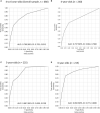Predictive validity of a parental questionnaire for identifying children with developmental language disorders
- PMID: 37404588
- PMCID: PMC10316708
- DOI: 10.3389/fpsyg.2023.1110449
Predictive validity of a parental questionnaire for identifying children with developmental language disorders
Erratum in
-
Erratum: Predictive validity of a parental questionnaire for identifying children with developmental language disorders.Front Psychol. 2023 Aug 10;14:1258680. doi: 10.3389/fpsyg.2023.1258680. eCollection 2023. Front Psychol. 2023. PMID: 37637894 Free PMC article.
Abstract
Background: The underdiagnosis of developmental language disorder (DLD) in children is a serious problem in developing countries with limited resources. It has long been noted that the concerns parents have about their children's health and development are richly informative, and if this information can be used for diagnosis, it may provide a means to address the problem of underdiagnosis of DLD. This study aimed to quantify the utility of parental linguistic concern questions (PLCQ) on the identification of language disorders in monolingual Spanish-speaking children in Mexico. It also explored whether a combination of biological and environmental conditions questions (BECQ) might improve the performance of a screening test to identify DLD.
Methods: A total of 680 monolingual Mexican Spanish-speaking children and their parents from urban areas in Mexico participated in the study. The distribution of responses to questions about DLD concerns was compared between 185 children diagnosed with DLD and 495 control subjects, and multiple logistic regression analysis was performed to select questions with high predictivity, based on the Akaike information criterion. The diagnostic utility of the questions was assessed by receiver operating characteristic (ROC) curves, stratum-specific likelihood ratios (SSLRs), and changes in pretest and post-test probabilities of DLD. A similar procedure was used to explore whether adding BECQ would improve the diagnostic utility of questions about DLD concerns using data of 128 children.
Results: Four questions regarding parental linguistic concerns were found to be useful in identifying children with DLD. When all four concerns were present, the SSLR was 8.79, while it was only 0.27 when there were no concerns at all. The estimates of DLD probability increased from 0.12 to 0.55 at pretest and post-test. On the other hand, the BECQ did not perform as well as the PLCQ in identifying DLD, and the improvement in diagnostic performance it provided was limited to one question.
Conclusion: The parental questionnaire can be used as a screening tool to help in identifying children with DLD. The data presented in this study underscore the importance of considering linguistic parental concerns as part of the screening process. This is a realistic option to provide a solution to the current problem of underdiagnosis of DLD in Mexico.
Keywords: Spanish-speaking children; developmental language disorder (DLD); early identification; parental linguistic concerns; parental questionnaires.
Copyright © 2023 Auza B., Murata and Peñaloza.
Conflict of interest statement
The authors declare that the research was conducted in the absence of any commercial or financial relationships that could be construed as a potential conflict of interest.
Figures
References
-
- Abutbul-Oz H., Armon-Lotem S. (2022). Parent questionnaires in screening for developmental language disorder among bilingual children in speech and language clinics. Front. Educ. 7:846111. 10.3389/feduc.2022.846111 - DOI
-
- Auza A., Murata C., Márquez M. E., Morgan G. (2018). Tamiz de problemas de lenguaje TPL. Ciudad de México: Manual Moderno.
-
- Auza A., Peñaloza C., Murata C. (2019). “The influence of maternal education on the linguistic abilities of monolingual Spanish-Speaking children with and without Specific Language Impairment,” in Atypical language development in Romance languages, eds Aguilar-Mediavilla E., Buil-Legaz L., López-Penadés R., Sanchez-Azanza V. A., Adrover-Roig D., et al. (Amsterdam: John Benjamins Publishing Company; ).
LinkOut - more resources
Full Text Sources
Miscellaneous


